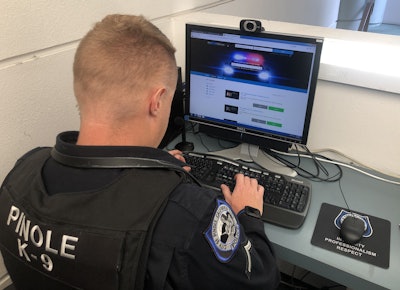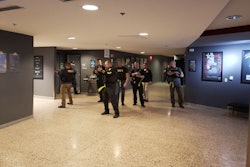 Using the training on ThinBlueOnLine.com, officers can build verbal communications skills in just minutes of work.Photo: ThinBlueOnLine
Using the training on ThinBlueOnLine.com, officers can build verbal communications skills in just minutes of work.Photo: ThinBlueOnLine
ThinBlueOnLine's verbal response training software offers law enforcement officers effective instruction that can be conducted in minutes.
The most important tool that a law enforcement officer has is their voice. Using the right words, in the right way and at the right time, can prevent a situation from escalating and has the power to save lives on both sides of the badge. ThinBlueOnLine.com provides online training that lets you build de-escalation and other communication skills through practice in a wide range of law enforcement encounters.
The Problem
Tactical training in the proper use of tools such as your sidearm, TASER, and baton is required in law enforcement. This is important, because when the time comes to use these devices in a life-or-death situation, their successful deployment and use needs to be smooth, accurate, and automatic. If you have to think about things like proper hand placement, or sight picture, or other fine details then your mind is too occupied to keep a proper focus on the developing tactical situation and optional strategies that can provide the best possible outcome.
Similarly, when it comes to using your voice in a critical situation you need to have built skills through practice ahead of time and planted memories of alternate approaches to common scenarios in your mind so that you can draw upon them to de-escalate encounters.
Too often during confrontations law enforcement officers simply repeat ineffective commands. "Show me your hands! Show me your hands! Show me your hands! Show me your hands!" If it didn't work the first four times, it is not likely to work on the fifth. So what can you do?
Many officers will simply repeat "Show me your hands!" and add "Do it now!" for emphasis, and hope for the best. And if that doesn't work they know they have to go hands-on and force the subject to comply. But that puts that officer, the subject, and fellow officers at risk.
These encounters happen thousands of times every day, across departments large and small. In some of these cases, taking a different approach could end the situation peacefully and without any application of force. Perhaps another approach could work. But in the heat of the moment, with the adrenaline pumping, who has time to think about something else to say?
The Solution
The best way to build skills is to practice them. You learn best by actually doing something and getting better all along the way. ThinBlueOnLine.com has spent years developing a technology where you can practice using your voice in law enforcement situations. This training can be accessed online, utilizing everyday computers and mobile devices, for just pennies per day. This training is written by past and present law enforcement officers, representing a variety of departments from coast to coast. Each scenario only takes a few minutes to practice, and the training can be put into practice immediately.
The training begins with a briefing where an officer is informed of the situation they are going to be practicing. Think of this briefing as containing the information the officer would receive from dispatch. The officer is then confronted with a subject that asks a question or makes a statement that requires a verbal response. The officer is encouraged to "wing it" and to respond as their instinct or experience tells them to do. They can then observe a role model response, delivered by a simulated officer in that situation, and receive instruction on the key elements of the best practice response.
If the officer is spot-on in the initial response, this builds positive reinforcement. If the officer's initial response did not match the best practice, this is an even better learning experience as the brain is forced to reconcile the differences between their response and that of the best practice.
In either case, the officer practices giving a verbal reply, using their own words while being sure to include all the key elements in their response. They can practice as often as they like until they feel confident that they can deliver a complete response with the appropriate command presence.
To assist during this self-study period, the officer can record and play back their responses to see how they look and sound, and to compare themselves to the provided role model. The learning process also provides insights along the way that supplement what should be said with why this particular approach is taken in this situation.
When the verbal response is mastered, the officer can move on to the next part of the encounter using the same challenge and verbal response practice methodology. When the scenario is completed the officer is presented with a debrief of the overall encounter, pointing out the main techniques that were employed. There are also tools included that allow for scoring by an FTO.
The net effect is that both new and experienced officers are presented with a scenario where they have to practice giving a verbal response along specific, structured lines, and they are presented with the explanation about why this particular approach is being utilized in this scenario. This builds memories of alternate approaches that can be immediately recalled on duty to provide the officer with better options in difficult encounters.
Case Study
Chief Neil Gang of the Pinole (CA) Police Department related this story to us:
Recently, a rookie patrol team completed a training session using the ThinBlueOnLine system. The weekly training scenario was a responding officer who speaks with an armed man who is angry and was threatening to harm himself and employees of a business. Going through the scenario, the patrol team felt that the process and steps of the virtual officer's actions were appropriate and provided a great example of the use of de-escalation skills.
One week later, the same rookie officers responded to virtually the same call as the scenario. A man armed with a knife was distraught and threatening his fellow employees and himself while sitting in his vehicle in the parking lot of his workplace. A Pinole PD Sergeant stated, "I was not sure exactly what to expect and planned on playing a larger role in the handling of this incident, due to the young officers' lack of experience in dealing with these types of situations."
The sergeant went on to say, "I was impressed when I observed our officers utilizing techniques and even verbiage directly from the ThinBlueOnLine training scenario that was covered a week prior during our briefing."
In this situation, the officers required very little input from their sergeant and were able to successfully de-escalate the situation, which resulted in a positive resolution. After approximately an hour and a half of dialogue with the distraught subject, he ultimately surrendered his weapon and cooperated with the officers. After the subject was taken into custody and placed into an ambulance for a mental health evaluation, he thanked the officers for making him feel comfortable enough to have a conversation with them and that he could trust them.
This is an example of just how valuable ThinBlueOnLine de-escalation training software can be for your officers, police department, and ultimately your community.
John DiGiantomasso is the President of ThinBlueOnLine.com.











